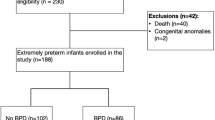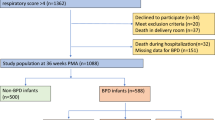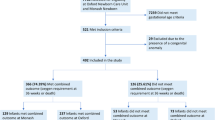Abstract
Introduction:
To better understand whether preeclampsia (PE) increases the risk of bronchopulmonary dysplasia (BPD).
Results:
Of 753 infants alive at 36 wks, 138 (18.3%) were exposed to PE. BPD was not significantly related to exposure to PE either before (odds ratio (OR) 0.73; 95% confidence interval (CI) 0.50, 1.06) or after adjustment for confounding variables (adjusted OR 1.14; 95% CI 0.71, 1.81). If infants were selected by gestational age alone, there was no association (OR 1.05; 95% CI 0.63, 1.75). In contrast, selecting by birth weight alone, PE was associated with a significant reduction in BPD (OR 0.61, 95% CI 0.41, 0.91). However, this effect disappeared after adjustment for confounding variables.
Discussion:
Conclusions were unchanged when data from other studies were included in a pooled analysis. PE does not significantly affect the risk of BPD in extremely preterm (EP) or extremely-low-birth-weight (ELBW) subjects.
Methods:
We examined data on EP (<28 wks gestation) or ELBW (<1,000 g) infants live born in Victoria, Australia, in three eras: 1991–1992, 1997, and 2005. We compared the incidence of BPD (oxygen requirement at 36 wks' postmenstrual age) in the PE group (infants exposed to PE) with that in the remainder (nonexposed infants). We also contrasted results with comparable reported studies.
Similar content being viewed by others
Log in or create a free account to read this content
Gain free access to this article, as well as selected content from this journal and more on nature.com
or
References
Sibai BM . Diagnosis and management of gestational hypertension and preeclampsia. Obstet Gynecol 2003;102:181–192.
Ness RB, Roberts JM . Heterogeneous causes constituting the single syndrome of preeclampsia: a hypothesis and its implications. Am J Obstet Gynecol 1996;175:1365–70.
Goldenberg RL, Rouse DJ . Prevention of premature birth. N Engl J Med 1998;339:313–20.
Roberts D, Dalziel S . Antenatal corticosteroids for accelerating fetal lung maturation for women at risk of preterm birth. Cochrane Database Syst Rev 2006;3:CD004454.
Soll RF . Surfactant treatment of the very preterm infant. Biol Neonate 1998;74: Suppl 1:35–42.
Akram Khan M, Kuzma-O’Reilly B, Brodsky NL, Bhandari V . Site-specific characteristics of infants developing bronchopulmonary dysplasia. J Perinatol 2006;26:428–35.
Bose C, Van Marter LJ, Laughon M, et al.; Extremely Low Gestational Age Newborn Study Investigators. Fetal growth restriction and chronic lung disease among infants born before the 28th week of gestation. Pediatrics 2009;124:e450–8.
Hansen AR, Barnés CM, Folkman J, McElrath TF . Maternal preeclampsia predicts the development of bronchopulmonary dysplasia. J Pediatr 2010;156:532–6.
Kim CR, Vohr BR, Oh W . Effects of maternal hypertension in very-low-birth-weight infants. Arch Pediatr Adolesc Med 1996;150:686–91.
Korhonen P, Tammela O, Koivisto AM, Laippala P, Ikonen S . Frequency and risk factors in bronchopulmonary dysplasia in a cohort of very low birth weight infants. Early Hum Dev 1999;54:245–58.
Redline RW, Wilson-Costello D, Hack M . Placental and other perinatal risk factors for chronic lung disease in very low birth weight infants. Pediatr Res 2002;52:713–9.
Wolf EJ, Vintzileos AM, Rosenkrantz TS, Rodis JF, Salafia CM, Pezzullo JG . Do survival and morbidity of very-low-birth-weight infants vary according to the primary pregnancy complication that results in preterm delivery? Am J Obstet Gynecol 1993;169:1233–9.
Yates JM, Lumley J, Bell RJ . The prevalence and timing of obstetric ultrasound in Victoria 1991-1992: a population-based study. Aust N Z J Obstet Gynaecol 1995;35:375–9.
Duley L . The global impact of pre-eclampsia and eclampsia. Semin Perinatol 2009;33:130–137.
Arnold CC, Kramer MS, Hobbs CA, McLean FH, Usher RH . Very low birth weight: a problematic cohort for epidemiologic studies of very small or immature neonates. Am J Epidemiol 1991;134:604–13.
The Victorian Infant Collaborative Study Group Improved outcome into the 1990s for infants weighing 500-999g at birth. Arch Dis Child Fetal Neonatal Ed 1997;77:F91–94.
The Victorian Infant Collaborative Study Group. Outcome at 2 years of children 23-27 weeks’ gestation born in Victoria in 1991-92. J Paediatr Child Health 1997;33:161–165.
Doyle LW; Victorian Infant Collaborative Study Group. Outcome at 5 years of age of children 23 to 27 weeks’ gestation: refining the prognosis. Pediatrics 2001;108:134–41.
Doyle LW; Victorian Infant Collaborative Study Group. Evaluation of neonatal intensive care for extremely low birth weight infants in Victoria over two decades: I. Effectiveness. Pediatrics 2004;113(3 Pt 1):505–9.
Doyle LW; Victorian Infant Collaborative Study Group. Neonatal intensive care at borderline viability–is it worth it? Early Hum Dev 2004;80:103–13.
Doyle LW, Roberts G, Anderson PJ . Outcomes at age 2 years of infants <28 weeks’ gestational age born in Victoria in 2005. J Pediatr 2010;156:49–52 e41.
Higgins JPT, Green S (updated September 2009). Cochrane Handbook for Systematic Reviews of Interventions version 5.0.2. The Cochrane Collaboration, Section 9.5.2, 2008. (http://www.cochrane-handbook.org.)
Author information
Authors and Affiliations
Consortia
Corresponding author
Rights and permissions
About this article
Cite this article
O’Shea, J., Davis, P., Doyle, L. et al. Maternal preeclampsia and risk of bronchopulmonary dysplasia in preterm infants. Pediatr Res 71, 210–214 (2012). https://doi.org/10.1038/pr.2011.27
Received:
Accepted:
Published:
Issue date:
DOI: https://doi.org/10.1038/pr.2011.27
This article is cited by
-
Loss of microRNA-30a and sex-specific effects on the neonatal hyperoxic lung injury
Biology of Sex Differences (2023)
-
Outcomes of singleton preterm very low birth weight infants born to mothers with pregnancy-induced hypertension
Scientific Reports (2023)
-
Maternal hypertensive disorders and survival without major morbidities among extremely low gestation newborns
Journal of Perinatology (2023)
-
The Association of Pregnancy-induced Hypertension with Bronchopulmonary Dysplasia – A Retrospective Study Based on the Korean Neonatal Network database
Scientific Reports (2020)
-
Hypertensive disorders during pregnancy are associated with reduced severe intraventricular hemorrhage in very-low-birth-weight infants
Journal of Perinatology (2019)



